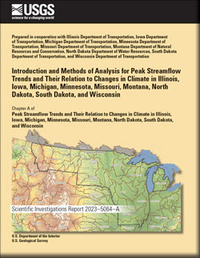Introduction and Methods of Analysis for Peak Streamflow Trends and Their Relation to Changes in Climate in Illinois, Iowa, Michigan, Minnesota, Missouri, Montana, North Dakota, South Dakota, and Wisconsin
Links
- Document: Report (44.2 MB pdf) , HTML , XML
- Larger Work: This publication is Chapter A of Peak streamflow trends and their relation to changes in climate in Illinois, Iowa, Michigan, Minnesota, Missouri, Montana, North Dakota, South Dakota, and Wisconsin
- Dataset: USGS National Water Information System database —USGS water data for the Nation
- Data Release: USGS data release - Peak streamflow data, climate data, and results from investigating hydroclimatic trends and climate change effects on peak streamflow in the Central United States, 1920–2020
- Download citation as: RIS | Dublin Core
Abstract
Flood-frequency analysis, also called peak-flow frequency or flood-flow frequency analysis, is essential to water resources management applications including critical structure design and floodplain mapping. Federal guidelines for doing flood-frequency analyses are presented in a U.S. Geological Survey Techniques and Methods Report known as Bulletin 17C. A basic assumption within Bulletin 17C is that for drainage basins without major hydrologic alterations, statistical properties of the distribution of annual peak streamflows (peak flows) are stationary; that is, the mean, variance, and skew are constant. The stationarity assumption has been widely accepted within the flood-frequency community; however, a better understanding of long-term climatic persistence and concerns about potential climate change and land-use change has caused a reexamination of the stationarity assumption. Flood-frequency analyses that do not incorporate observed trends and abrupt changes may result in a poor representation of the true flood risk. Bulletin 17C does not offer guidance for incorporating nonstationarities when estimating floods, and it describes a need for studies that incorporate changing climate or basin characteristics. In response to this need and a history of concern regarding nonstationarity peak flows in the region, this study was done by the U.S. Geological Survey, in cooperation with the Departments of Transportation of Illinois, Iowa, Michigan, Minnesota, Missouri, South Dakota, and Wisconsin; the Montana Department of Natural Resources and Conservation; and the North Dakota Department of Water Resources, to assess potential nonstationarity in peak flows in the north-central United States.
This chapter summarizes the methods used to detect hydroclimatic changes in peak-flow data in the study region. A wide range of analyses and statistical approaches are applied to document the primary mechanisms controlling floods and characterize temporal changes in hydroclimatic variables and peak flow. Four periods were selected for analysis of peak flow, daily streamflow, and climate data. The periods are (1) a 100-year period, 1921–2020; (2) a 75-year period, 1946–2020; (3) a 50-year period, 1971–2020; and (4) a 30-year period, 1991–2020. The climate data consist of monthly time series estimates of temperature, precipitation, potential evapotranspiration, actual evapotranspiration, snowfall, soil moisture storage, snow water equivalent, and runoff on a 3.1-mile by 3.1-mile grid for the conterminous United States.
Statistical and graphical analyses were used to investigate potential changes in hydrology and climate. The starting point for these analyses was the initial data analysis of peak flow described in Bulletin 17C, which includes plotting the peak flow and checking for autocorrelation, monotonic trends, and changes points. Analyses were added to examine additional features in the data. To examine potential causal drivers of changes, the climate data were analyzed graphically and statistically. Results are provided in a U.S. Geological Survey data release. The study limitations are documented for users of the results.
Suggested Citation
Ryberg, K.R., Over, T.M., Levin, S.B., Heimann, D.C., Barth, N.A., Marti, M.K., O’Shea, P.S., Sanocki, C.A., Williams-Sether, T.J., Wavra, H.N., Sando, T.R., Sando, S.K., and Liu, M.S., 2024, Introduction and methods of analysis for peak streamflow trends and their relation to changes in climate in Illinois, Iowa, Michigan, Minnesota, Missouri, Montana, North Dakota, South Dakota, and Wisconsin, chap. A of Ryberg, K.R., comp., Peak streamflow trends and their relation to changes in climate in Illinois, Iowa, Michigan, Minnesota, Missouri, Montana, North Dakota, South Dakota, and Wisconsin: U.S. Geological Survey Scientific Investigations Report 2023–5064, 27 p., https://doi.org/10.3133/sir20235064A.
ISSN: 2328-0328 (online)
Study Area
Table of Contents
- Acknowledgments
- Abstract
- Introduction
- Data Selection
- Methods
- Results
- Study Limitations
- Summary
- References Cited
| Publication type | Report |
|---|---|
| Publication Subtype | USGS Numbered Series |
| Title | Introduction and methods of analysis for peak streamflow trends and their relation to changes in climate in Illinois, Iowa, Michigan, Minnesota, Missouri, Montana, North Dakota, South Dakota, and Wisconsin |
| Series title | Scientific Investigations Report |
| Series number | 2023-5064 |
| Chapter | A |
| DOI | 10.3133/sir20235064A |
| Publication Date | January 25, 2024 |
| Year Published | 2024 |
| Language | English |
| Publisher | U.S. Geological Survey |
| Publisher location | Reston, VA |
| Contributing office(s) | Illinois Water Science Center, Minnesota Water Science Center, Dakota Water Science Center, Central Midwest Water Science Center, Upper Midwest Water Science Center |
| Description | Report: vi, 27 p.; Data Release; Dataset |
| Larger Work Type | Report |
| Larger Work Subtype | USGS Numbered Series |
| Larger Work Title | Peak Streamflow Trends and Their Relation to Changes in Climate in Illinois, Iowa, Michigan, Minnesota, Missouri, Montana, North Dakota, South Dakota, and Wisconsin |
| Country | United States |
| State | Iowa, Illinois, Michigan, Missouri, Minnesota, Montana, North Dakota, South Dakota, Wisconsin |
| Online Only (Y/N) | Y |
| Additional Online Files (Y/N) | N |


